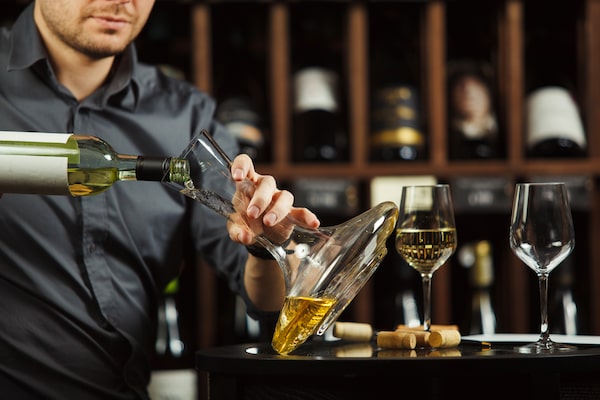
Close up portrait of caucasian sommelier pouring white wine from opened bottle in decanter designed to degustate and taste alcohol beverages, cellar full with containers collection having labels placed on shelvesIL21/iStockPhoto / Getty Images
The decision whether to decant a wine is often based on tradition. Is it red and old? Fetch your decanter and let the ceremony begin.
Using a decanter to separate an aged wine from the solids (phenolic compounds, tannins and tartrates) which can fall out of solution during aging results in a more intense and expressive red wine, with a smoother and more refined texture.
It’s common to find tartrate crystals in older white wines, a crystalline deposit that can look like sea salt that’s sometimes called “wine diamonds,” but decanting isn’t prescribed nearly as often. There’s concern that the wine’s fragile character has more to lose than gain by extensive exposure to air.
There are differing opinions about how and when to decant young red wines, usually based on whether rapid exposure to air is beneficial to the wine or not, much less thought is given to how or why it might improve white wines. When there’s no exact formula, you can let personal preference take charge.
Most modern wines are well filtered and aren’t necessarily designed for ageing, which means they’re unlikely to contain sediment, but you might consider decanting them for other reasons.
Decanting and serving a young wine — white, red or rosé — can help remove sulfurous aromas or volatile compounds that might have formed during production and bottling. For instance, I find most Marlborough sauvignon blancs as well as other aromatic wines bottled with a screwcap closure benefit from a quick decant. My practice is to open the bottle and pour it into a decanter, pitcher or other clean container and then funnel it back into the bottle.
It’s a way for the wine to “open up” or “breathe” to use two industry terms for aeration, which is believed to unmask a wine’s fruity and floral aromas and flavours. Too much aeration will have a negative effect, which is why I double decant back into the bottle for serving. History has also proven that friends and family have no issue serving themselves from a bottle, but when a decanter is placed on the table, I end up playing sommelier for the evening.
Younger barrel aged chardonnay or white wines from the Rhône are other styles that may benefit from decanting. More time in the decanter can add richness to these wines, which might add to its appeal. (Swirling in a larger bowled wine glass has a similar effect for me, so I leave my decanter on the shelf.)
Decanting white wine can also help adjust its temperature. Pouring a refrigerated white into a room temperature decanter will help speed up the warming process, which also enhances fruity aromas and flavours in the wine. While you can chill wine more quickly by placing a decanter into an ice bucket as it’s typically made of thinner glass than a conventional bottle.
One final consideration, there’s a performative element to decanting. Serving wine out of a fancy decanter changes the context. It elevates the experience. Just be mindful of how fancy a decanter you select, lest you spend your evening pouring wine for people.